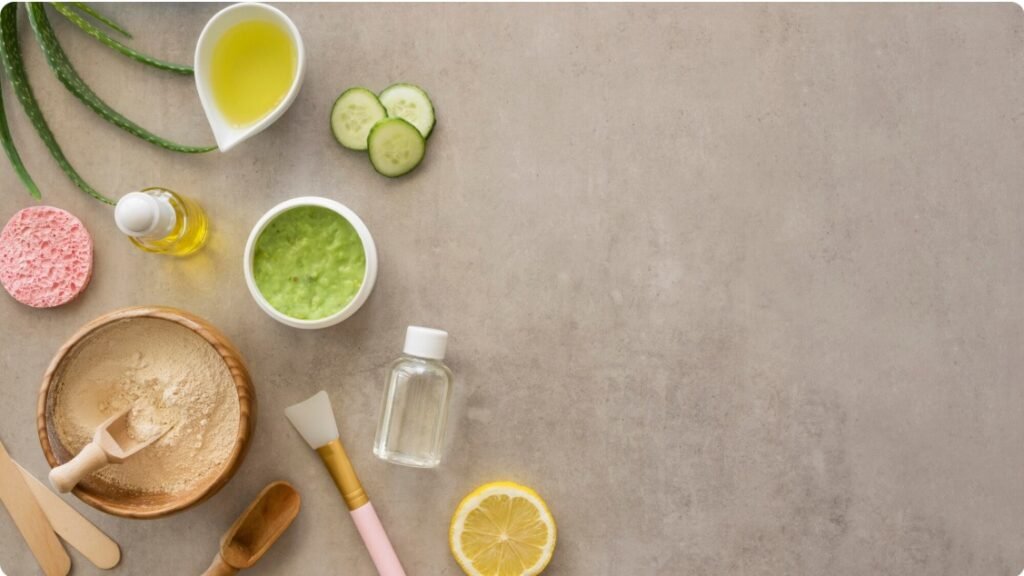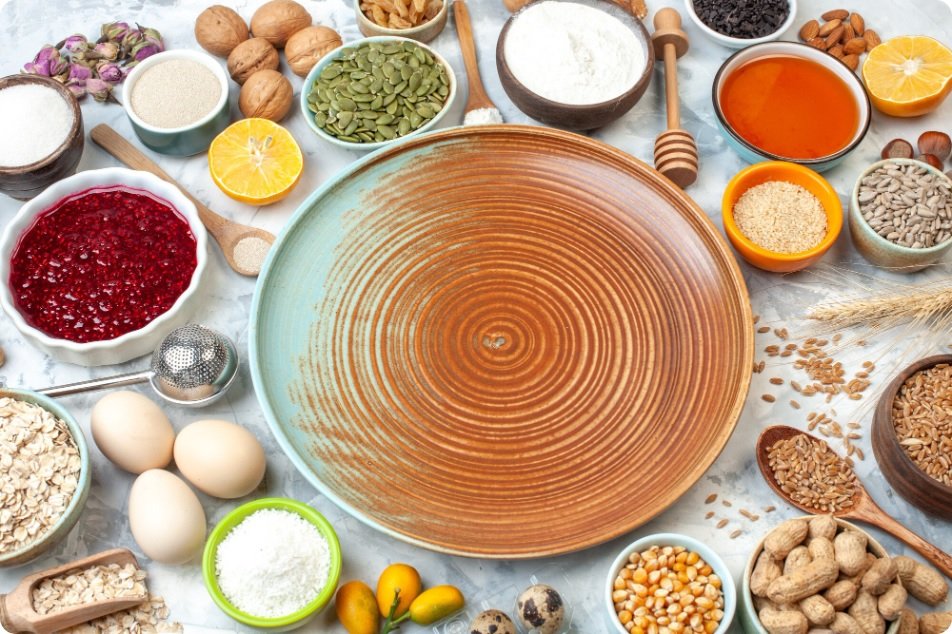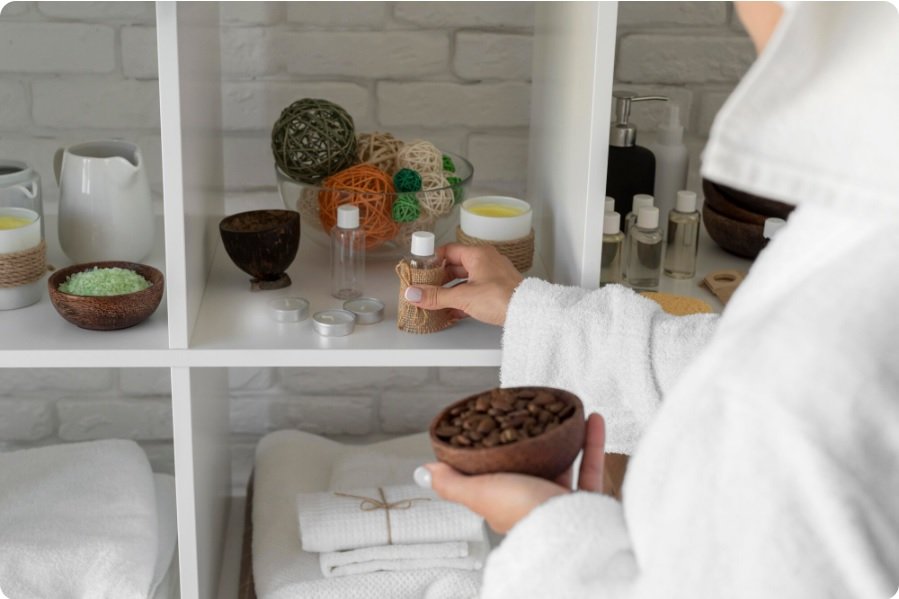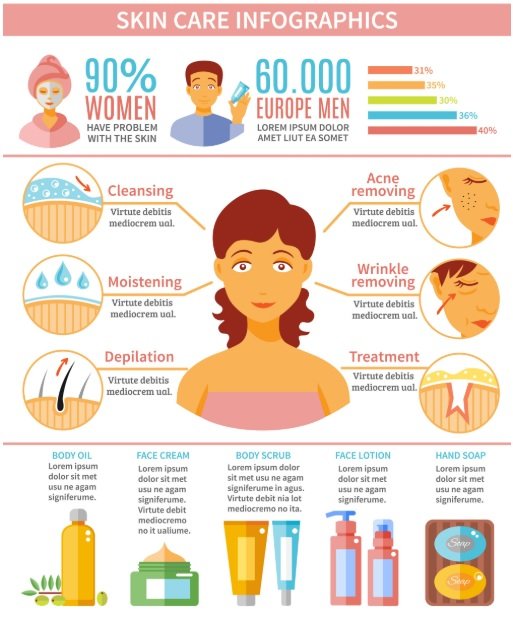
The modern beauty world has witnessed a remarkable shift toward natural, chemical-free skin care solutions. More people are discovering that effective skincare doesn’t always require expensive products filled with synthetic ingredients. Instead, many are turning to home remedies that utilize simple, accessible ingredients found right in their kitchen pantries.
Natural skincare approaches offer numerous benefits beyond just being cost-effective. These gentle alternatives work harmoniously with the skin’s natural processes, reducing the risk of irritation that often comes with harsh commercial products. From honey’s antibacterial properties to oatmeal’s soothing effects, nature provides a treasure trove of ingredients that can help achieve that coveted healthy glow.
This comprehensive guide will explore practical remedies using everyday kitchen staples, helping readers understand how to create effective skincare routines without breaking the bank. However, it’s important to note that while home remedies can be incredibly beneficial for maintaining healthy skin, certain conditions may require professional attention. Persistent skin issues, severe acne, or unusual changes should always be evaluated by a dermatologist.

Understanding Your Skin Type
Before diving into specific remedies, understanding one’s skin type forms the foundation of any successful skincare regimen. The five basic skin types each have distinct characteristics and require tailored approaches for optimal results.
Identifying Your Skin Type
Oily skin typically appears shiny, especially in the T-zone area, and may be prone to enlarged pores and frequent breakouts. Those with this skin type often struggle with excess sebum production throughout the day.
Dry skin feels tight, particularly after cleansing, and may show signs of flaking or rough patches. This skin type lacks adequate natural oils and often requires intensive moisturizing.
Combination skin presents the most complex scenario, with oily areas (usually the forehead, nose, and chin) alongside dry or normal cheeks. This mixed condition requires different treatments for different facial zones.
Sensitive skin reacts easily to products, weather changes, or environmental factors, often resulting in redness, burning, or stinging sensations.
Normal skin maintains a healthy balance of oil and moisture, appearing smooth and even-toned with minimal concerns.
Simple At-Home Testing Methods
The tissue test provides a quick way to determine skin type. After cleansing the face with a gentle cleanser and waiting one hour without applying any products, press clean tissues to different areas of the face. Oily areas will leave visible oil marks on the tissue, while dry areas will show little to no residue.
Another effective method involves observing how the skin feels throughout the day. Normal skin remains comfortable, while oily skin becomes increasingly shiny. Dry skin may feel tight or uncomfortable, and combination skin will show varying conditions across different facial areas.
Why Skin Type Matters
Understanding skin type directly impacts ingredient selection for home remedies. While honey works wonderfully for most skin types due to its gentle nature, ingredients like lemon juice may be too harsh for sensitive skin. Similarly, heavy oils might overwhelm already oily skin but provide perfect nourishment for dry skin types.
Seasonal changes also affect skin behavior. Cold weather often makes skin drier, while humidity can increase oil production. Adjusting natural remedies according to these fluctuations ensures consistent results throughout the year.

Essential Natural Ingredients and Their Benefits
Nature’s pharmacy offers countless ingredients that can transform ordinary skincare routines into effective treatments. Understanding the properties of these natural powerhouses helps in creating targeted solutions for specific skin concerns.
Kitchen Staples
Honey stands out as one of nature’s most versatile skincare ingredients. Its natural antibacterial properties make it excellent for treating minor blemishes while its humectant qualities help skin retain moisture. Raw, unprocessed honey contains enzymes and antioxidants that promote healing and provide gentle exfoliation.
Oatmeal serves as a gentle exfoliant that soothes inflammation simultaneously. Its saponins create a mild cleansing action, while beta-glucan provides anti-inflammatory benefits. Ground oatmeal works particularly well for sensitive skin types that cannot tolerate harsher scrubs.
Turmeric brings powerful anti-inflammatory and brightening effects to skincare routines. This golden spice contains curcumin, which helps reduce redness and can gradually improve skin tone. However, it may temporarily stain the skin yellow, so patch testing is essential.
Lemon provides natural bleaching properties and vitamin C benefits, making it useful for addressing dark spots and uneven skin tone. Its citric acid content offers gentle exfoliation, though its photosensitizing properties require careful use and sun protection.
Cucumber offers exceptional cooling and hydrating properties, making it perfect for soothing irritated or inflamed skin. Its high water content provides instant hydration, while its antioxidants help protect against environmental damage.
Yogurt contains natural lactic acid, which provides gentle exfoliation while its probiotics may help balance skin’s natural microbiome. The proteins in yogurt can help tighten and firm the skin temporarily.
Pantry Powerhouses
Coconut oil combines moisturizing properties with antimicrobial benefits, making it suitable for dry skin types. Its lauric acid content helps fight bacteria, while its rich texture provides deep hydration.
Olive oil brings antioxidants and deep moisturizing capabilities to skincare routines. Rich in vitamin E and other nutrients, it works particularly well for mature or very dry skin types.
Baking soda offers gentle exfoliation properties but requires careful use due to its alkaline nature. When used sparingly and properly diluted, it can help remove dead skin cells and unclog pores.
Apple cider vinegar helps balance skin’s pH levels while providing toning benefits. Its acetic acid content offers mild exfoliation and may help with minor breakouts when properly diluted.
Fresh Ingredients
Aloe vera provides exceptional healing and anti-inflammatory properties, making it ideal for treating sunburns, minor cuts, or irritated skin. Its cooling effect offers immediate relief for various skin concerns.
Avocado delivers intense moisture along with vitamins A, D, and E. Its rich, creamy texture makes it perfect for nourishing dry or mature skin types.
Tomatoes contain lycopene, a powerful antioxidant that may help protect against environmental damage. Their natural astringent properties can help tighten pores and control oil production.
Green tea provides potent antioxidants that may help prevent signs of aging while its anti-inflammatory properties soothe irritated skin. Used as a toner or in face masks, it offers multiple benefits for various skin concerns.

Daily Skincare Routine Using Natural Ingredients
Creating an effective daily routine with natural ingredients requires understanding how different components work together throughout the day. A well-structured regimen addresses cleansing, toning, and moisturizing while considering the skin’s changing needs from morning to night.
Morning Routine
The morning skincare routine focuses on preparing and protecting the skin for the day ahead. Starting with proper cleansing sets the foundation for all subsequent steps.
Gentle Cleansing begins with a honey and oat cleanser that removes overnight impurities without stripping natural oils. Combining one tablespoon of ground oatmeal with one teaspoon of raw honey creates a gentle, nourishing cleanser suitable for most skin types. This mixture provides mild exfoliation while honey’s antibacterial properties help prevent breakouts.
Toning follows with either rose water for its balancing properties or cooled green tea for its antioxidant benefits. These natural toners help restore skin’s pH balance while providing additional nutrients. Rose water works particularly well for sensitive skin, while green tea offers more targeted benefits for acne-prone or mature skin types.
Moisturizing involves applying light oils like jojoba or rosehip seed oil, or an aloe vera-based moisturizer for those preferring gel textures. The key lies in using just enough product to hydrate without leaving the skin feeling greasy or heavy.
Sun protection remains crucial even when using natural ingredients. While some natural ingredients like coconut oil provide minimal SPF protection, they cannot replace proper sunscreen for adequate protection against harmful UV rays.
Evening Routine
Evening routines focus on deeper cleansing, treatment, and repair while the skin naturally regenerates overnight.
Deep cleansing utilizes the oil cleansing method, where natural oils dissolve makeup, sunscreen, and accumulated impurities. Massaging coconut oil or olive oil into dry skin, then removing with a warm, damp cloth, effectively cleanses without harsh stripping.
Exfoliation occurs two to three times weekly using sugar or oatmeal scrubs. Combining brown sugar with honey creates an effective yet gentle exfoliant that removes dead skin cells while providing moisturizing benefits.
Treatment applications target specific concerns using concentrated natural ingredients. This might include applying diluted tea tree oil to blemishes or using a vitamin C-rich tomato treatment for brightening effects.
Night moisturizing involves heavier applications of nourishing oils like avocado oil or rich creams made from natural ingredients. The skin’s increased nighttime absorption makes this the ideal time for intensive treatments.

Targeted Treatments for Common Skin Concerns
Different skin concerns require specific approaches using targeted natural ingredients. Understanding which ingredients address particular issues helps create more effective treatment strategies.
Acne and Breakouts
Acne treatment with natural ingredients focuses on reducing inflammation, fighting bacteria, and preventing future breakouts without over-drying the skin.
Tea tree oil spot treatment provides powerful antibacterial action against acne-causing bacteria. Diluting one part tea tree oil with nine parts carrier oil creates a safe spot treatment that can be applied directly to blemishes.
Turmeric and honey mask combines anti-inflammatory turmeric with antibacterial honey for a powerful acne-fighting treatment. Mixing one teaspoon turmeric powder with two tablespoons honey creates a mask that can be applied for 15-20 minutes before rinsing.
Clay masks with natural ingredients help absorb excess oil while providing additional benefits. Bentonite clay mixed with apple cider vinegar creates a detoxifying mask that helps unclog pores and reduce oiliness.
Dietary considerations also play a role in acne management. Reducing dairy consumption and processed foods while increasing water intake and anti-inflammatory foods can support skin health from within.
Dark Spots and Hyperpigmentation
Addressing dark spots naturally requires patience and consistent application of brightening ingredients over several months.
Lemon and honey lightening mask combines vitamin C from lemon with honey’s healing properties. Mixing one tablespoon fresh lemon juice with two tablespoons honey creates a treatment that should be used in the evening due to lemon’s photosensitizing effects.
Tomato and yogurt treatment provides lycopene and lactic acid for gentle brightening. Blending one small tomato with two tablespoons plain yogurt creates a mask rich in antioxidants and natural acids.
Potato juice application offers a gentler alternative to citrus-based treatments. Raw potato juice contains vitamin C and mild bleaching properties that may help fade dark spots over time.
Results from natural brightening treatments typically become visible after 6-8 weeks of consistent use, with full benefits appearing after 3-4 months of regular application.
Dry and Flaky Skin
Addressing severely dry skin requires intensive moisturizing approaches combined with gentle exfoliation to remove flaky patches.
Avocado and honey deep moisture mask provides intensive hydration through avocado’s natural oils and honey’s humectant properties. Mashing half a ripe avocado with one tablespoon honey creates a rich, nourishing treatment.
Oatmeal and milk soothing treatment offers gentle exfoliation while providing immediate relief for irritated, flaky skin. Grinding oatmeal into powder and mixing with whole milk creates a calming treatment that can be used daily.
Natural oil recommendations include argan oil for its lightweight texture, coconut oil for intensive moisture, and sweet almond oil for sensitive skin types. These oils can be applied to damp skin for enhanced absorption.
Environmental factors like using a humidifier, avoiding hot water when cleansing, and protecting skin from harsh weather conditions support natural treatments for dry skin.
Signs of Aging
Natural anti-aging approaches focus on promoting collagen production, providing antioxidants, and maintaining skin elasticity through nourishing treatments.
Egg white firming mask provides temporary tightening effects while delivering proteins that may support skin structure. Whisking one egg white until frothy and applying as a mask offers immediate firming benefits.
Banana and honey anti-aging treatment combines vitamins and minerals from banana with honey’s healing properties. Mashing one ripe banana with one tablespoon honey creates a nourishing mask rich in potassium and vitamins.
Natural vitamin C serums can be created using fresh orange juice diluted with rose water, though commercial vitamin C serums typically provide more stable and effective concentrations.
Facial massage techniques using natural oils improve circulation and may help maintain skin firmness. Gentle upward strokes using rosehip seed oil or argan oil provide both massage benefits and nourishing ingredients.
Under-Eye Care
The delicate under-eye area requires gentle treatments that address puffiness, dark circles, and fine lines without causing irritation.
Cucumber slice treatment provides immediate cooling relief for puffy eyes while delivering hydration to the thin under-eye skin. Chilled cucumber slices applied for 10-15 minutes offer quick results for occasional puffiness.
Cold green tea bag compress utilizes caffeine’s constricting properties to reduce puffiness while providing antioxidants. Used tea bags, chilled in the refrigerator, can be applied to closed eyes for 10 minutes.
Natural caffeine treatments using cooled coffee grounds mixed with a small amount of coconut oil create a gentle scrub that may help improve circulation around the eyes.
Gentle massage methods using ring fingers and light circular motions with a drop of vitamin E oil can help improve lymphatic drainage and reduce puffiness over time.

Weekly Deep Treatment Recipes
Intensive weekly treatments provide concentrated benefits that daily routines cannot achieve alone. These deeper treatments address specific concerns while providing luxurious self-care experiences.
Hydrating Masks
Recipe 1: Honey, Avocado, and Oatmeal Mask
- 1/2 ripe avocado, mashed
- 1 tablespoon raw honey
- 1 tablespoon ground oatmeal
This rich combination provides intensive moisture through avocado’s natural oils while honey attracts and retains moisture. Oatmeal adds gentle exfoliation and anti-inflammatory benefits. Apply to clean skin for 20 minutes, then rinse with lukewarm water.
Recipe 2: Yogurt and Cucumber Cooling Mask
- 2 tablespoons plain Greek yogurt
- 1/4 cucumber, grated and drained
- 1 teaspoon honey
Perfect for hot weather or irritated skin, this cooling mask combines yogurt’s lactic acid with cucumber’s soothing properties. The probiotics in yogurt may help balance skin’s natural microbiome while providing gentle exfoliation.
Recipe 3: Banana and Olive Oil Nourishing Treatment
- 1 ripe banana, mashed
- 1 teaspoon extra virgin olive oil
- 1 teaspoon honey
Ideal for mature or very dry skin, this treatment provides vitamins A and E from banana, antioxidants from olive oil, and moisturizing benefits from honey. The combination creates a creamy, luxurious mask that deeply nourishes.
Exfoliating Treatments
Recipe 1: Brown Sugar and Honey Scrub
- 2 tablespoons brown sugar
- 1 tablespoon raw honey
- 1 teaspoon coconut oil
This gentle yet effective scrub removes dead skin cells while providing moisturizing benefits. Brown sugar’s smaller granules make it suitable for facial use, while honey’s antibacterial properties help prevent breakouts.
Recipe 2: Coffee Grounds and Coconut Oil Scrub
- 2 tablespoons used coffee grounds
- 1 tablespoon coconut oil
- 1 teaspoon honey
Perfect for body use, this energizing scrub improves circulation while providing caffeine’s potential skin-tightening benefits. The coconut oil moisturizes while coffee grounds provide effective exfoliation.
Recipe 3: Oatmeal and Lemon Gentle Exfoliant
- 2 tablespoons ground oatmeal
- 1 teaspoon fresh lemon juice
- 1 tablespoon yogurt
Suitable for sensitive skin, this gentle exfoliant combines oatmeal’s soothing properties with lemon’s brightening effects and yogurt’s lactic acid. Use only in evening routines due to lemon’s photosensitizing properties.
Brightening Treatments
Recipe 1: Turmeric, Yogurt, and Honey Glow Mask
- 1 teaspoon turmeric powder
- 2 tablespoons plain yogurt
- 1 tablespoon honey
This powerful brightening mask combines turmeric’s anti-inflammatory properties with yogurt’s gentle exfoliation and honey’s healing benefits. May temporarily tint skin yellow, so patch test first and rinse thoroughly.
Recipe 2: Lemon, Honey, and Oat Brightening Treatment
- 1 teaspoon fresh lemon juice
- 1 tablespoon honey
- 1 tablespoon ground oatmeal
A gentler approach to brightening that combines vitamin C from lemon with oatmeal’s soothing properties. Use only in evening routines and always follow with sunscreen the next day.
Recipe 3: Tomato and Yogurt Vitamin-Rich Mask
- 1/2 fresh tomato, pureed
- 2 tablespoons plain yogurt
- 1 teaspoon honey
Rich in lycopene and natural acids, this mask provides antioxidant benefits while gently exfoliating. The combination helps improve skin texture while potentially reducing signs of environmental damage.

Lifestyle Factors for Healthy Skin
Achieving radiant skin extends far beyond topical treatments. Fundamental lifestyle choices significantly impact skin health and can either support or undermine even the best skincare routines.
Hydration
Proper hydration forms the cornerstone of healthy skin. The general recommendation of eight glasses of water daily provides a starting point, though individual needs vary based on climate, activity level, and overall health. Well-hydrated skin appears plumper, more resilient, and better able to perform its barrier functions.
Beyond plain water, herbal teas, particularly green tea with its antioxidant benefits, contribute to both hydration and skin health. Cucumber water and coconut water offer additional electrolytes that support cellular function.
Diet
Skin-friendly nutrition emphasizes foods rich in antioxidants, healthy fats, and vitamins that support skin structure and function. Colorful fruits and vegetables provide vitamin C for collagen synthesis, while foods rich in omega-3 fatty acids help maintain skin’s lipid barrier.
Specific nutrients play targeted roles in skin health. Vitamin E protects against oxidative damage, zinc supports healing and may help with acne management, and vitamin A promotes cell turnover. Including nuts, seeds, fatty fish, and leafy greens ensures adequate intake of these essential nutrients.
Foods to limit include excessive sugar, which may accelerate aging through glycation, and dairy products, which some individuals find triggers breakouts.
Sleep
Quality sleep provides essential time for skin repair and regeneration. During deep sleep phases, blood flow to the skin increases, collagen production peaks, and cellular damage from daily environmental exposure gets repaired.
Sleep deprivation manifests visibly through dark circles, dull complexion, and accelerated signs of aging. Establishing consistent sleep schedules and creating optimal sleep environments supports both overall health and skin appearance.
Using silk pillowcases may reduce friction that can contribute to wrinkles and hair breakage, while ensuring adequate humidity in sleeping areas prevents excessive skin drying.
Stress Management
Chronic stress triggers hormonal changes that can worsen various skin conditions, from acne to eczema to premature aging. Stress hormones like cortisol can increase oil production, slow healing, and break down collagen.
Effective stress management techniques include regular meditation, deep breathing exercises, yoga, or any activity that promotes relaxation and mental well-being. Regular exercise also helps manage stress while improving circulation that benefits skin health.
Exercise
Physical activity improves circulation, delivering oxygen and nutrients to skin cells while helping remove waste products. The increased blood flow during exercise gives skin a healthy, natural glow that no topical treatment can replicate.
Post-workout skincare becomes crucial, as sweat and bacteria can clog pores if not promptly cleansed. Gentle cleansing with natural ingredients immediately after exercise prevents breakouts while maintaining the circulation benefits.

Safety Guidelines and Precautions
While natural ingredients are generally gentler than synthetic alternatives, they can still cause adverse reactions in sensitive individuals. Proper safety protocols ensure positive experiences with natural skincare approaches.
Patch Testing
Patch testing should precede the use of any new ingredient, regardless of its natural origin. Apply a small amount of the prepared treatment to the inner wrist or behind the ear, then wait 24-48 hours to observe for any signs of irritation, redness, or allergic reaction.
Even familiar ingredients can cause reactions when used in new combinations or concentrations. Seasonal allergies or hormonal changes can also affect skin sensitivity, making patch testing important even for previously used ingredients.
Common Allergens
Several popular natural ingredients commonly cause allergic reactions. Tree nuts, including almond oil and walnut scrubs, can trigger severe reactions in allergic individuals. Citrus fruits may cause contact dermatitis, particularly when combined with sun exposure.
Essential oils, while beneficial for many, represent concentrated plant compounds that can cause sensitization or photosensitivity. Always dilute essential oils properly and research their specific precautions before use.
Honey, while generally well-tolerated, can cause reactions in individuals allergic to bee products or specific pollens.
Ingredients to Avoid by Skin Type
Sensitive skin should avoid high concentrations of citrus juices, undiluted essential oils, and harsh physical exfoliants like salt or baking soda. These ingredients can cause immediate irritation or long-term damage to compromised skin barriers.
Acne-prone skin might react poorly to heavy oils like coconut oil, which can be comedogenic for some individuals. While natural doesn’t guarantee non-comedogenic properties, lighter oils like jojoba typically cause fewer breakouts.
Mature skin should use anti-aging ingredients like retinol alternatives (bakuchiol) carefully, starting with lower concentrations to assess tolerance.
When to Stop Using a Remedy
Discontinue any treatment immediately if signs of allergic reaction occur, including widespread redness, swelling, burning sensations, or respiratory symptoms. Increased breakouts, persistent irritation, or worsening of the target condition also indicate that a treatment isn’t suitable.
Some initial reactions, like mild tingling from certain acids or temporary redness from circulation-boosting ingredients, may be normal. However, any uncomfortable or worsening symptoms warrant discontinuation and possibly professional consultation.
Interaction Warnings
Certain natural ingredients don’t mix well together or with conventional treatments. Citrus-based treatments can increase sensitivity to retinoids or other prescription medications. Oil-based treatments may reduce the effectiveness of water-based products applied afterward.
Some combinations can cause chemical reactions that irritate skin or reduce effectiveness. For example, vitamin C and benzoyl peroxide can neutralize each other, while certain essential oils become phototoxic when combined.
[Image Suggestion: Infographic showing patch testing steps and warning signs to watch for]
Creating Your Personal Natural Skincare Routine
Developing an effective personalized routine requires careful assessment of individual needs, gradual implementation, and consistent monitoring of results.
Assessing Your Needs
Begin by identifying primary skin concerns and establishing realistic goals. While natural ingredients can significantly improve skin health and appearance, they typically work more gradually than conventional treatments. Setting appropriate expectations prevents disappointment and encourages consistency.
Consider lifestyle factors that impact skincare needs. Those living in dry climates may need more intensive moisturizing approaches, while individuals in humid environments might require lighter formulations or more frequent cleansing.
Age-related needs also influence ingredient selection. Younger skin might focus on prevention and oil control, while mature skin typically benefits more from nourishing and firming treatments.
Building Gradually
Start with one or two basic products rather than implementing a complete routine immediately. This approach allows skin to adjust while making it easier to identify which ingredients provide benefits or cause problems.
Begin with gentle, well-tolerated ingredients like honey or oatmeal before introducing potentially sensitizing components like citrus juices or essential oils. Add new ingredients one at a time, waiting at least a week between additions to monitor individual effects.
Tracking Progress
Maintain a simple skincare journal documenting which ingredients are used, when they’re applied, and any observed changes in skin condition. Photos taken in consistent lighting can help track gradual improvements that might not be immediately noticeable.
Note both positive and negative reactions, including factors like weather, stress levels, or dietary changes that might influence skin condition. This information helps refine routines and identify patterns over time.
Seasonal Adjustments
Skin needs change throughout the year, requiring routine modifications to maintain optimal results. Winter typically demands richer moisturizers and more gentle exfoliation, while summer might call for lighter formulations and increased antioxidant protection.
Seasonal ingredient availability also influences natural skincare routines. Fresh cucumber and tomatoes provide peak benefits during summer months, while root vegetables and preserved ingredients work better during winter.
Budget-Friendly Tips
Maximize ingredient versatility by choosing multipurpose items. Honey works as a cleanser, mask, spot treatment, and moisturizing ingredient. Oatmeal serves as both a gentle exfoliant and soothing mask base.
Buy ingredients in appropriate quantities to prevent waste. Many fresh ingredients have short shelf lives, making smaller purchases more economical despite higher per-unit costs.
Consider growing herbs like aloe vera or making larger batches of shelf-stable ingredients like herbal toners that can be refrigerated for extended use.

Troubleshooting Common Issues
Even well-planned natural skincare routines can encounter challenges. Understanding how to address common problems helps maintain consistency and achieve desired results.
Initial Worsening
Some individuals experience temporary skin worsening when switching to natural ingredients, often called a “purging” period. This typically occurs when ingredients increase cell turnover or help bring existing congestion to the surface.
True purging should improve within 4-6 weeks and only occur in areas where breakouts normally happen. Worsening in new areas or persisting beyond six weeks suggests an allergic reaction or unsuitable ingredients rather than purging.
During potential purging periods, maintain consistent routines while avoiding the temptation to add more products or increase treatment frequency, which can worsen irritation.
Adjusting for Sensitivities
Sensitive skin requires modifications to standard recipes and application methods. Reduce concentrations of active ingredients, shorten contact times, and always follow potentially irritating treatments with soothing ingredients like aloe vera or oatmeal.
Dilution often makes harsh ingredients more tolerable. Lemon juice can be mixed with equal parts water, and essential oils should always be heavily diluted in carrier oils before use.
Temperature also affects sensitivity. Lukewarm water prevents irritation, while ice-cold treatments can provide relief for inflamed or irritated skin.
Ingredient Availability Issues
Seasonal availability affects fresh ingredient access, requiring substitutions or preservation methods. Frozen fruits often retain most beneficial compounds and provide year-round access to seasonal ingredients.
Create dried herb preparations during peak seasons for use throughout the year. Properly dried and stored herbs maintain potency for 6-12 months when stored in airtight containers away from light and heat.
Develop substitute ingredient knowledge. Rose water can replace cucumber juice for soothing properties, while different oils can often be substituted based on similar fatty acid profiles.
Climate Modifications
Humid climates may require lighter formulations, more frequent cleansing, and antimicrobial ingredients to prevent bacterial growth. Dry climates demand richer moisturizers, gentle exfoliation, and protection from environmental factors.
Extreme temperatures affect ingredient stability and skin needs. Hot weather may require refrigerated treatments for comfort and preservation, while cold weather might necessitate gentler formulations to avoid further drying compromised skin barriers.
Travel considerations include choosing stable ingredients that won’t spoil without refrigeration and adjusting routines for different climates or water qualities encountered during trips.

Natural skincare approaches offer accessible, gentle, and effective alternatives to commercial products filled with synthetic ingredients. Throughout this comprehensive guide, readers have discovered how common kitchen staples can transform ordinary routines into powerful treatments for various skin concerns.
The key benefits of natural skincare extend beyond just being cost-effective. These ingredients work harmoniously with skin’s natural processes, reducing the likelihood of adverse reactions while providing targeted benefits for specific concerns. From honey’s antibacterial properties to turmeric’s anti-inflammatory effects, nature provides solutions that have been trusted for centuries.
Success with natural skincare requires patience and consistency. Unlike commercial products that might show immediate but temporary results, natural ingredients typically work gradually to create lasting improvements in skin health and appearance. This slower approach actually benefits skin by supporting its natural functions rather than forcing rapid changes.
Individual skin differences mean that what works wonderfully for one person might not suit another. The journey of discovering the perfect combination of natural ingredients becomes part of the self-care process, encouraging mindful attention to how skin responds to different treatments and environmental factors.
Starting with one simple remedy – perhaps a basic honey cleanser or oatmeal mask – provides an excellent introduction to natural skincare. As confidence grows and skin responds positively, gradually expanding the routine with additional ingredients creates a personalized system that addresses individual needs and concerns.
The integration of proper lifestyle factors amplifies the benefits of topical treatments. Adequate hydration, balanced nutrition, quality sleep, stress management, and regular exercise create the foundation upon which natural skincare ingredients can work most effectively.

Additional Resources
Quick Reference Guide: Skin Type → Recommended Ingredients
Oily Skin: Clay masks, tea tree oil (diluted), green tea toner, lightweight oils (jojoba), salicylic acid alternatives (willow bark)
Dry Skin: Avocado masks, honey treatments, rich oils (coconut, olive), oatmeal cleansers, milk-based treatments
Combination Skin: Gentle cleansers (honey-oat), targeted treatments (clay on T-zone, moisturizing on cheeks), balanced toners (rose water)
Sensitive Skin: Oatmeal treatments, cucumber masks, aloe vera gel, chamomile preparations, minimal ingredient formulations
Normal Skin: Versatile ingredients (honey, yogurt), antioxidant treatments (green tea), gentle exfoliation (brown sugar scrubs)
Seasonal Skincare Calendar
Spring: Gentle detox masks, light exfoliation, vitamin C treatments, preparation for increased sun exposure
Summer: Cooling treatments (cucumber, aloe), antioxidant protection, oil-free hydration, after-sun care
Fall: Repair treatments for summer damage, gradual increase in moisturizing, preparation for drier weather
Winter: Intensive moisturizing, gentle cleansing, protective barriers, humidifying treatments
Shopping List: Essential Natural Ingredients
Pantry Essentials: Raw honey, coconut oil, olive oil, apple cider vinegar, baking soda, brown sugar
Fresh Ingredients: Aloe vera plant, lemons, cucumber, avocados, bananas, tomatoes
Dried Goods: Oatmeal, green tea bags, turmeric powder, sea salt
Optional Additions: Essential oils (tea tree, lavender), clay (bentonite, kaolin), rose water
Measurement Conversions for Recipe Modifications
1 tablespoon = 3 teaspoons = 15ml
1/4 cup = 4 tablespoons = 60ml
1/2 cup = 8 tablespoons = 120ml
1 cup = 16 tablespoons = 240ml
When scaling recipes up or down, maintain ingredient ratios for consistent results. Most face mask recipes can be halved for single use or doubled for multiple applications or sharing.